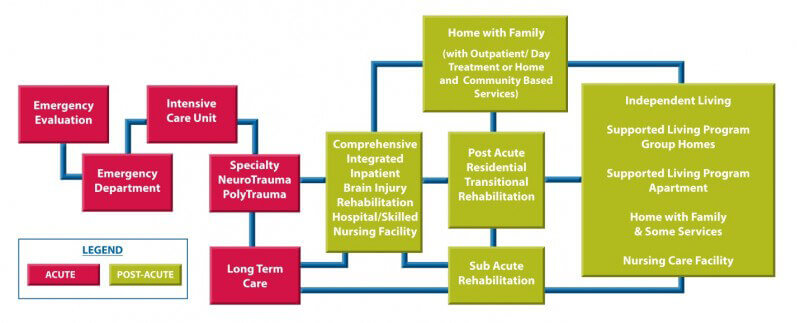Your Cart is Empty
- HOME
- THE BRAIN
- SERVICES
- ABOUT US
- CAREER
- FOR HOME CARE NEEDS
- Terms of Service
- Login

As recovery progresses following brain injury, it is likely the individual will see a change in the level of care and in the treatment setting. Since individuals do not always progress in a linear fashion, they will not always advance through the continuum of care in strict order.
Treatment in a hospital following a brain injury can range from a quick neurological assessment to longer-term, inpatient care. The length of one’s stay in the hospital will vary depending on the severity and implications from the brain injury.
It is likely one will first visit the Emergency Department, or Emergency Room (ER), following a brain injury. Oftentimes the decisions in the ER must be made quickly and without explanation. The treatment team focuses on saving lives. Measures to protect the brain from further injury or damage will be taken.
After receiving emergency medical treatment, persons with a moderate to severe brain injury may be admitted to a hospital’s Inpatient Intensive Care Unit (ICU). The goal in ICU is typically medical stability, management, and prevention of medical crisis. Those receiving treatment in the ICU for their brain injury may be unconscious, in a coma, and/or medically unstable. Many tubes, wires, and pieces of medical equipment may be attached to the patient to provide life sustaining medical care. The time in ICU is oftentimes quite upsetting and emotional for caregivers, loved ones, and family members. It is important for family members and caregivers to remember to take care of themselves throughout this time, as well.
During the time spent in the ICU, you will likely hear the treatment team mention or use important medical equipment.
Once medically stable, an individual may be moved to a room within the Step Down Unit (SDU). SDUs provide an intermediate level of care between the Intensive Care Units (ICUs) and the general medical-surgical wards. These units also may be referred to intermediate or transitional care units. Likely the individual will receive slightly more rehabilitation (perhaps an hour or so more per day) than they did in the ICU.